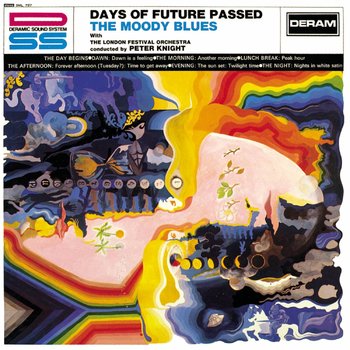
Letters I've written never meaning to send
Removes the colours from our sight.
Red is grey and yellow white
But we decide which is right
And which is an illusion."
Days of Future Passed is the second studio album recorded by British rock band The Moody Blues. It was released through Deram Records on November 10, 1967, in the United Kingdom, and the next day in the United States.
It was also the first album to feature Justin Hayward and John Lodge after the departure of Denny Laine and Clint Warwick. Leading up to the album's release, The Moody Blues had faced financial difficulties after the debut album The Magnificent Moodies did not achieve commercial success, and Decca Records offered for the band to record an LP for their new sublabel Deram that intersperses their music with orchestral backing. The band went to work on a Concept Album involving a day in the life of an everyday man, with them and the London Festival Orchestra playing at separate times except in "Nights in White Satin".
The album sold steadily, no doubt helped with "Nights in White Satin" receiving regular radio play, which led to the single peaking at #3 on the Billboard Hot 100 in 1972. It is regarded as one of the earliest identifiable examples of Progressive Rock, especially with the incorporation of symphonic music.
Tracklist:
Side One
- "The Day Begins" (5:50)
- "The Day Begins" - 4:08
- "Morning Glory"note - 1:42
- "Dawn: Dawn is a Feeling" (3:48)
- "The Morning: Another Morning" (3:55)
- "Lunch Break: Peak Hour" (5:33)
Side Two
- "The Afternoon" (8:23)
- "Tuesday Afternoon"note - 5:06
- "(Evening) Time to Get Away"note - 3:17
- "Evening” (6:40)
- "The Sunset" - 3:17
- "Twilight Time" - 3:23
- "The Night" (7:24)
- "Nights in White Satin" - 5:38
- "Late Lament/Resolvement"note - 1:46
Principal Members:
- Graeme Edge - drums, percussion, vocals
- Justin Hayward - guitars, piano, sitar, vocals
- John Lodge - bass, vocals
- Mike Pinder - keyboards, tamboura, gong, vocals
- Ray Thomas - flutes, percussion, piano, vocals
Tropes in white satin:
- Album Closure: Days of Future Passed charts a day from dawn to nightfall. The last track on the albumnote is a spoken-word piece on the aimless futility of life and the inevitable demise of any sort of optimism, called "Late Lament."
- Book Ends:
- The very first sound we hear is a gong being struck, played in reverse so that it gets steadily louder from near silence. The very last sound we hear is the same sound of a gong, this time played forwards.
- The first words on the album, as written by Graeme Edge and recited by Mike Pinder, are "Cold-hearted orb that rules the night / Removes the colours from our sight / Red is grey, and yellow, white / But we decide which is right / And which is an illusion." The same five lines re-appear as the last words on the album at the end of "Late Lament".
- Concept Album: The tracks in the song all involve the time of day, beginning at dawn and ending at night.
- Cue the Sun: The end of "Morning Glory" invokes this as the day begins:Brave Helios, wake up your steeds.
Bring the warmth the countryside needs. - Design Student's Orgasm: The album cover features an elaborate psychedelic painting that ties in with its Progressive Rock sound and its concept about the course of a single day.
- Echoing Acoustics: The vocals gather an echo effect in the "Evening" suite, particularly just before "Twilight Time".
- Gainax Ending: The gong at the end of "The Night", after two orchestral flourishes that make much more musical sense.
- George Lucas Altered Version: An example where a remix had to be made because the master tapes deteriorated not even a decade later. Eventually, tape restoration technology reached the point where the masters could be feasibly repaired, and the original mix was recovered just in time for release of the 2017 remaster.
- Melancholy Moon: As portrayed in the Book Ends, the moon was described in such a manner, where color gives way to gray and white.
- New Sound Album: Starting off as yet another rhythm 'n blues band in the British Invasion, this album shaped The Moody Blues' identity as a symphonic Progressive Rock band.
- The Not-Remix: The album was remixed in 1978 after the original master tapes deteriorated. This version remained standard until 2017, when the 1967 mix finally saw a re-release for the album's 50th anniversary (with the double-CD+DVD release including it alongside the remix).
- Scare Chord: "The Night" does this with a gong at the end.
- Siamese Twin Songs: "The Afternoon" transitions to "Evening", given that the last song in the former suite is "(Evening) Time to Get Away".
- Spoken Word in Music: Starts it off, acts as The Stinger to the final song, and sprinkled throughout.
Removes the colours from our sight.
Red is grey and yellow white
But we decide which is right
And which is an illusion.
